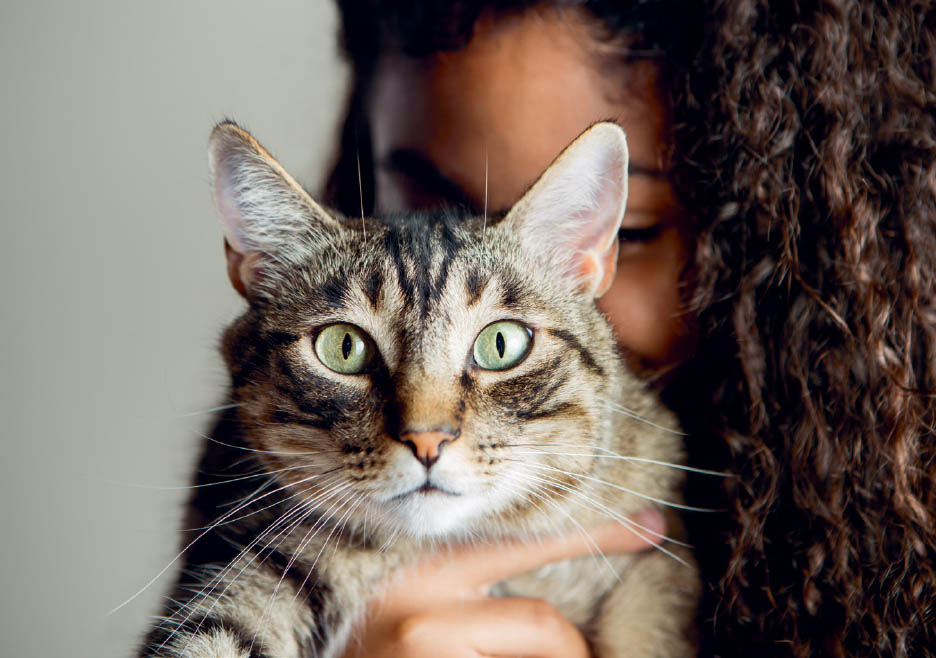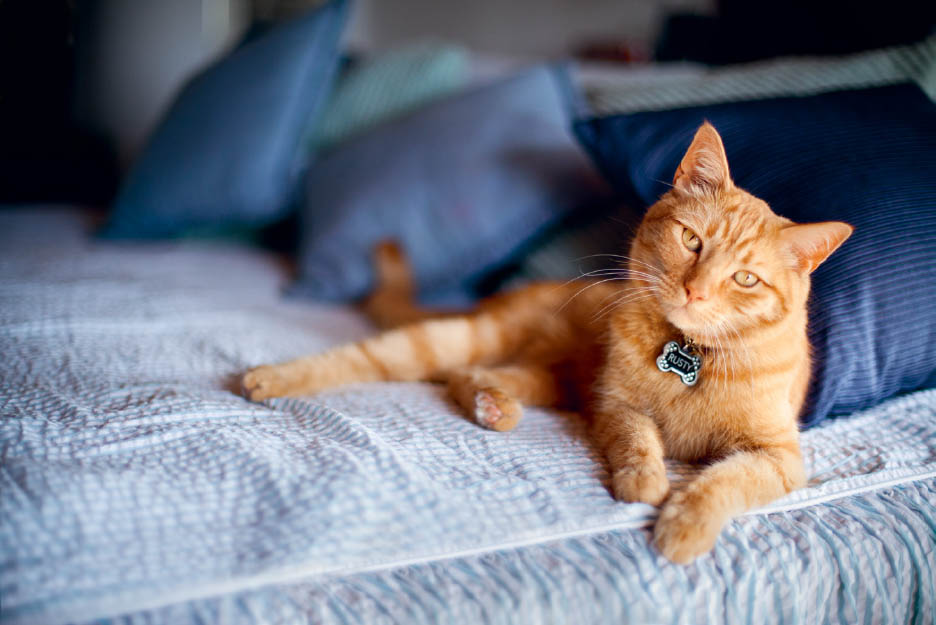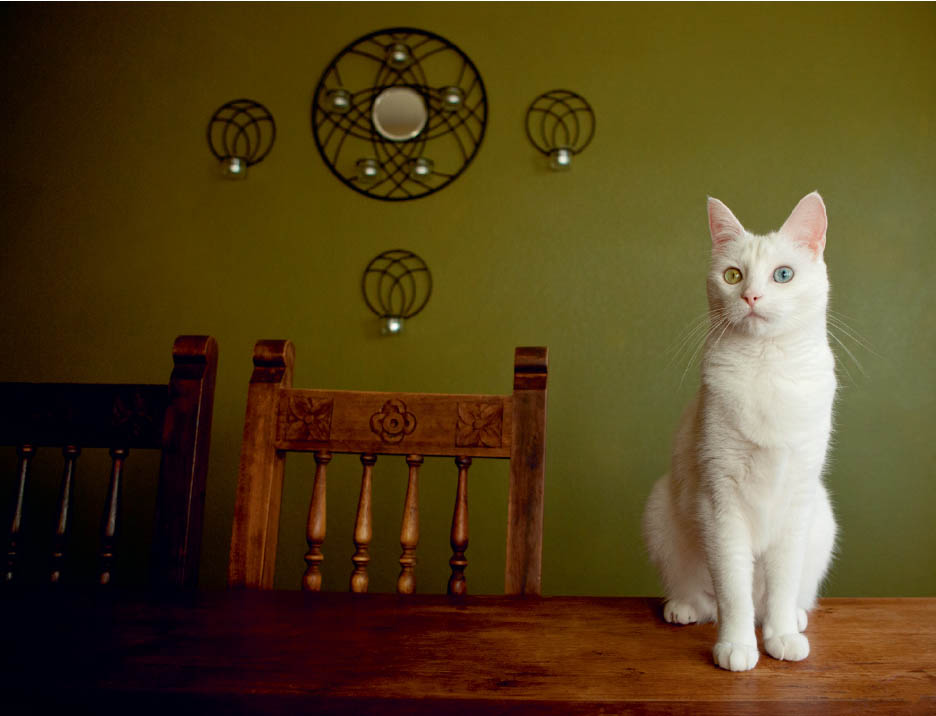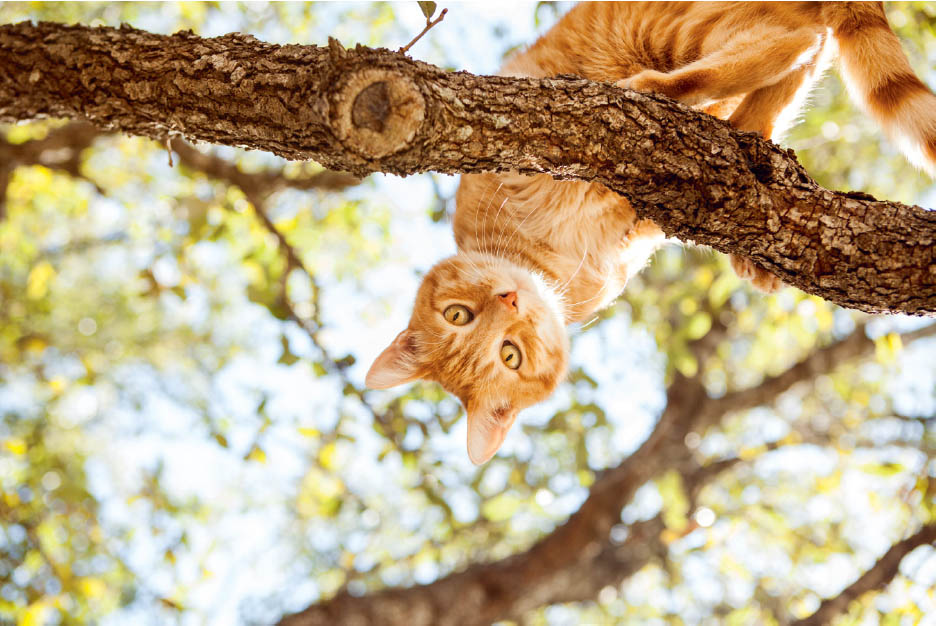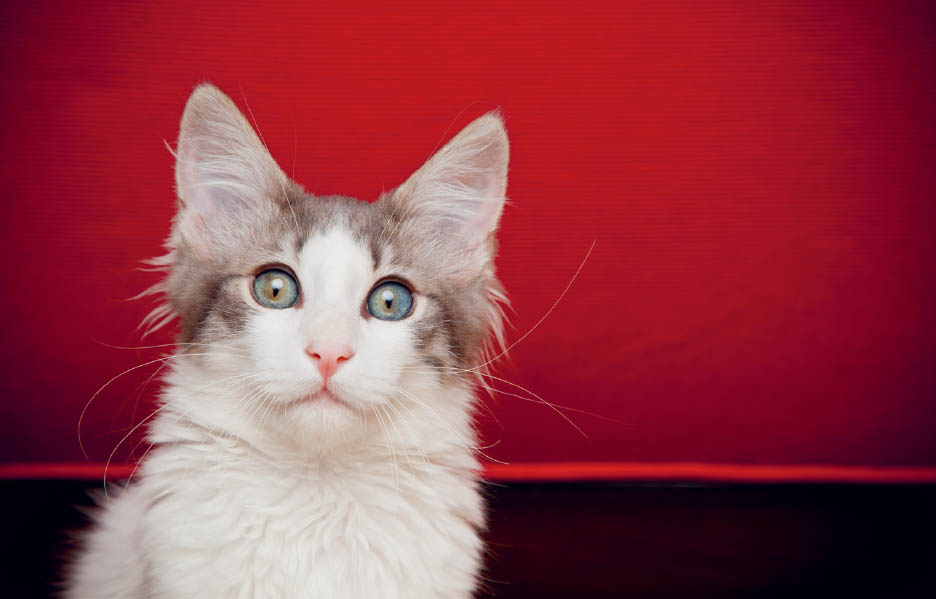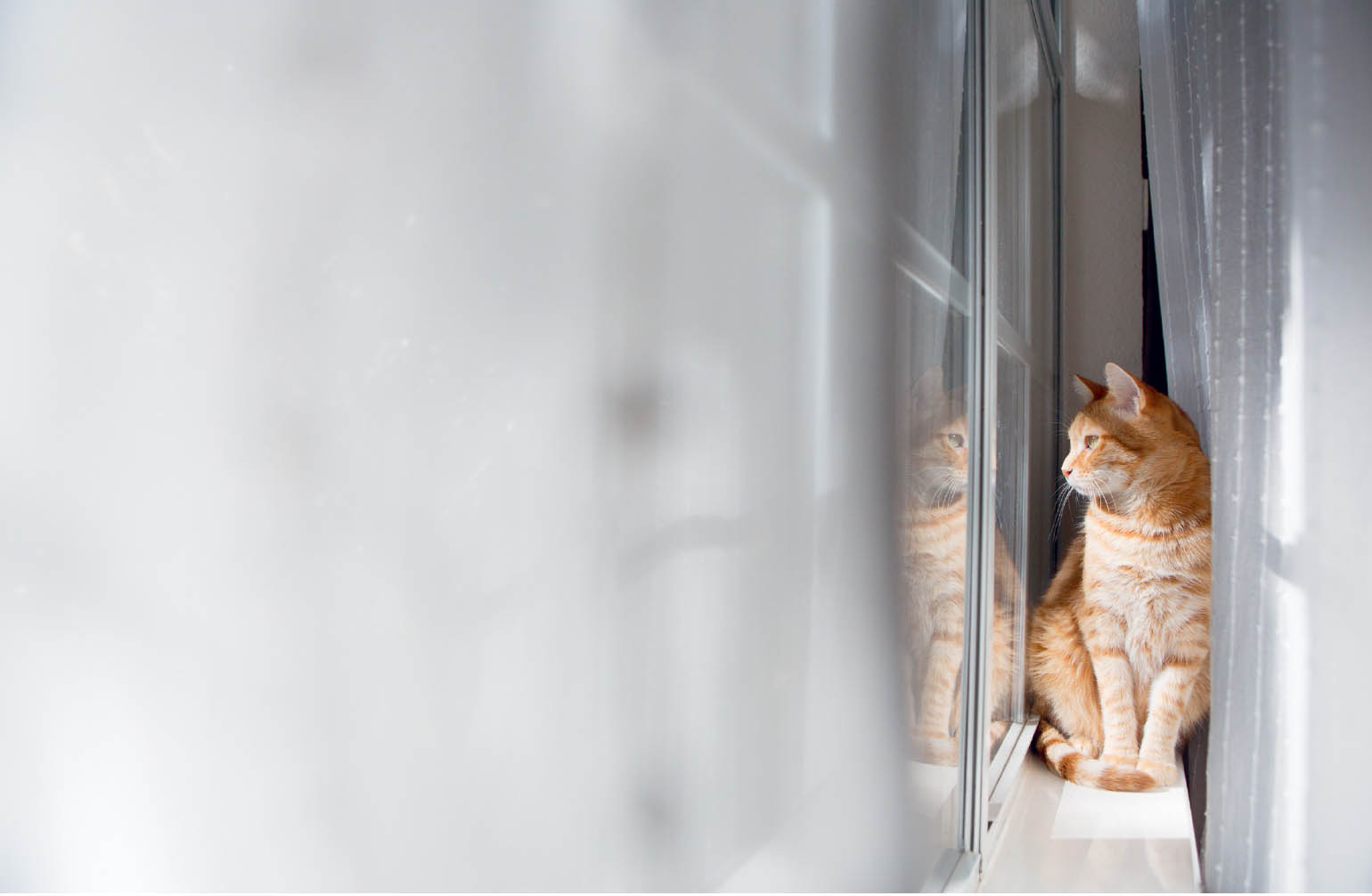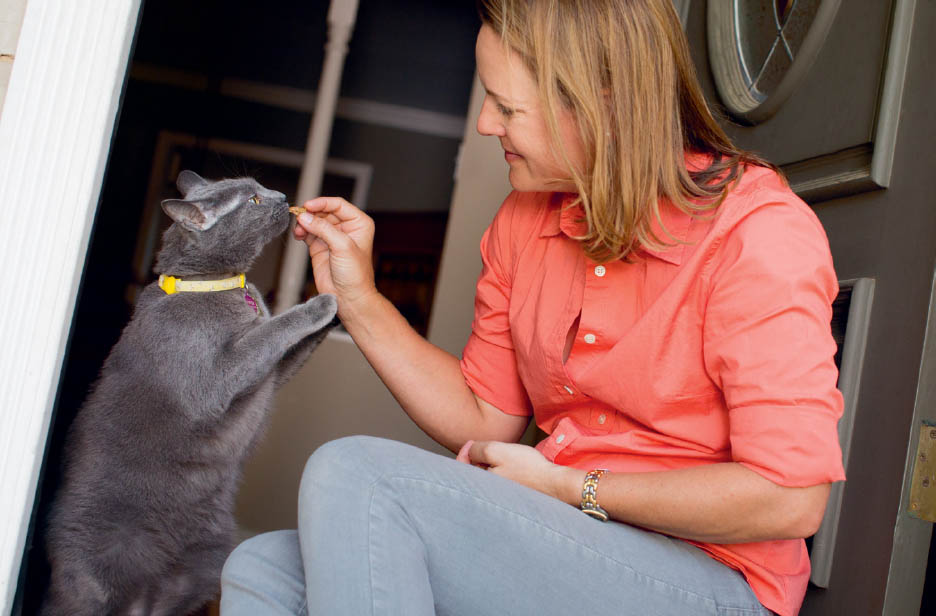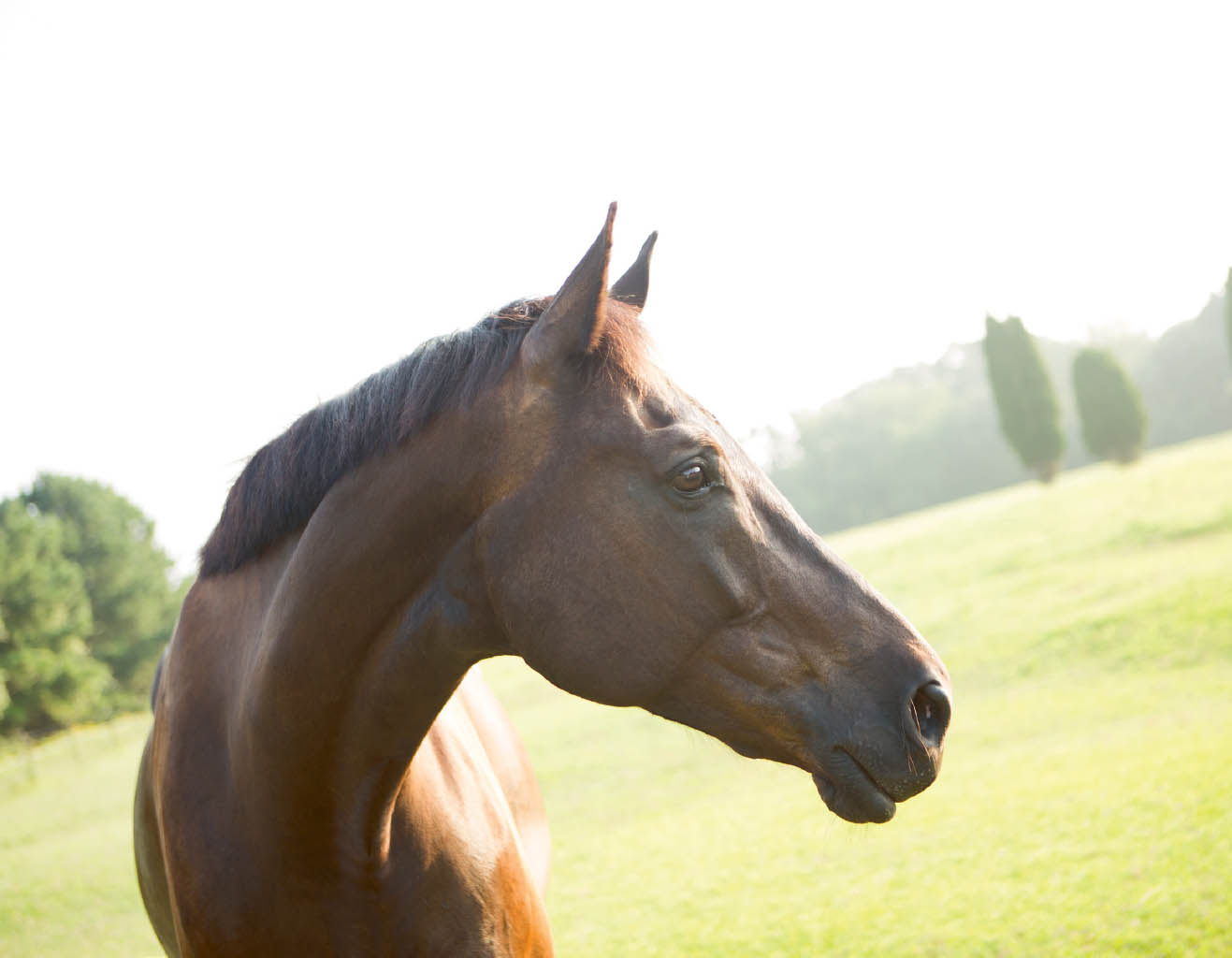CHAPTER 8: PHOTOGRAPHING CATS
It’s no secret that I adore cats. I think they are beautiful, intriguing, loving little beings that offer companionship to many, including myself. Photographing cats comes with different challenges than photographing other pets—that’s no surprise. However, they possess just the right amount of mystery and sass to keep things interesting during the photo shoot, and these traits can really shine through in your portraits in a stunning way.
While cats aren’t typically as popular as dogs in terms of commissioned portraits, they deserve to be photographed with just as much consideration. You may find yourself photographing your own cats at home, at an animal shelter, or as part of a commissioned portrait on location or in-studio. Getting tuned in to their unique behavior and creating awareness around what’s possible will help you navigate your cat photography pursuits.
Understanding Cat Behavior
I’d be a liar if I said that photographing cats is easy. This adventure is certainly challenging for reasons unique to their species. But I think the images that you can create for yourself and others are worth the extra effort and commitment it takes to capture them.
Ideally, we want cats in our photographs to be relaxed or playful and not scared or angry. Happy cats are much better in photographs than the alternative—both visually and experientially. It’s important to look at both the positive, happy signals, as well as the stress signals, to set up your photo shoot experience for success.
Developing a general understanding of feline communication that occurs via body language and through verbal means is going to help you as a pet photographer. As you begin to recognize cats’ methods of communication, you will be empowered to adapt your behavior and approach as needed for the success of your photo session and for everyone’s well-being.

RELAXED, HAPPY CATS
Cats really share their opinions about their surroundings and circumstances with you. Like dogs and other animals, cats will respond to their environment both verbally and with their body language. Of course, cats all have different personalities, and not all will act or respond the same way. Some cats are verbal and action-oriented, while others are more sedentary and low-key.
Contented cats can exhibit many different signs of communication. Some show signs of curiosity as they check out you and your equipment by rifling through your bags. They might be playful or respond to playful cues. Mr. Kitty may instantly rub up against your leg or “headbutt” you (which is actually a way for him to get his scent on you but is nonetheless a positive sign that he is comfortable with you).
If a cat is really comfortable with you, he may lie on the floor, wiggle around a bit, and show you his belly as if to beg you for love and attention. He may even knead a blanket, the bed, or the air. This behavior is so cute to me—and impossible to resist. Although it might seem strange, a super relaxed cat may even drool!
If you have permission to pick up the cat and notice a soft space between their shoulder blades, they are relaxed.
A cat with soft, partially closed eyes is likely comfortable. Perked ears that are directed forward tell us that Mr. Kitty is ready for his closeup and not overly stressed. Also, a cat’s tail can give you a lot of helpful feedback. No movement or a slow “swooshing” movement of the tail is typically a sign of a calm feline.
While cats are generally pretty quiet, some can be very vocal and will share lots of “opinions” with you. Meowing or little cat “barks” can certainly tell you that a cat is happy but wants attention of some sort. Purring is typically indicative of a happy cat, although this sound can also be used as a calming mechanism and can mean that the cat is under a bit of stress and trying to calm itself.
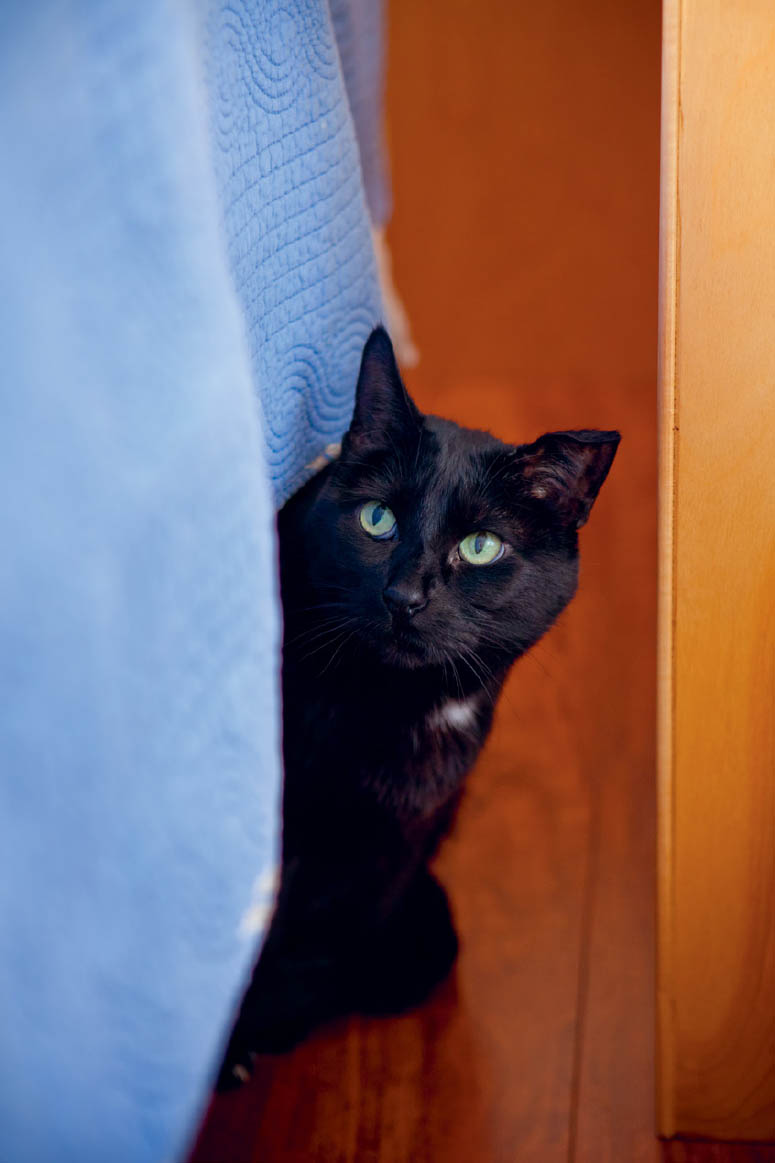
Cats have many ways of communicating their reaction to their environment and to you. This cat was nervous and wanted to hide as a response.
STRESSED CATS
When cats are stressed, they will let you know in a variety of ways. Their most common physical reaction when being photographed on location is to disappear by hiding in rooms or underneath furniture. This can be very challenging and is certainly an indicator that they need some time to get used to you.
Cats display other types of body language beyond the disappearing act. A stressed cat may try to make themselves look larger by raising the fur on their back and tail or standing sideways to increase the dramatic effect. They might twitch or swoosh their tail very quickly and in short bursts, indicating that they are either stressed or irritated in some way or that they are feeling extra spunky and want to play. (This “play” could result in pouncing on you or your camera, so be prepared.) If a cat’s ears are pinned back to their head, they are either not happy or feeling super feisty. In either case, I advise that you adjust something you’re doing so they can calm down a bit. Also, as opposed to calm cats, the space between the shoulder blades will be very tight, indicating tension.

Mr. Stinky’s ears pulled back along his head indicate that he isn’t in the mood for photographs at this particular moment. His look can be one of stress but also an indicator of possible feisty behavior to come.
A very upset cat could try to scratch or bite, but this type of behavior will usually be preceded by other body language signals. Scratching can sometimes occur through play, so it’s always best to have the pet parent trim their nails prior to the session, if possible.
Angry or scared cats will generally hiss if they are afraid or angry and even growl at you with a deep sound that you can quickly recognize as an indicator of unhappiness. Like dogs, a stressed cat will shed an excess of fur and will lick his or her lips.
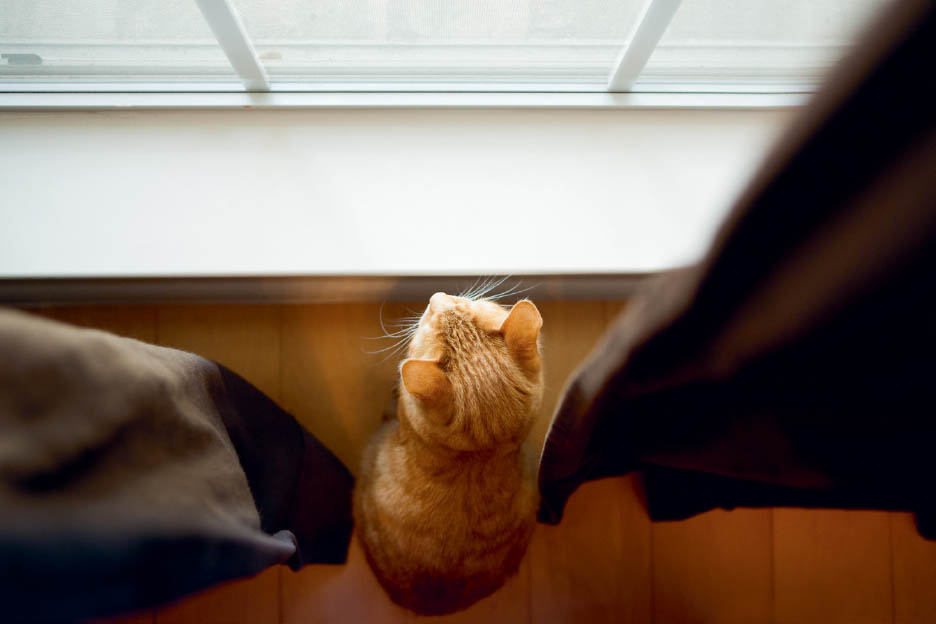
Just like with other pets, it’s a good idea to gather information ahead of time about the typical behavior and demeanor of the cat, as well as find out how they usually react to strangers in the house.
SLEEPY CATS
If you’re not familiar with cats, you should know that they sleep a LOT! While they may not be sleeping the entire time you are photographing, it’s important to know that this is the norm for them. I love sleepy cat portraits, and you’ll want to get some of those if you have the opportunity. However, you will likely want more than portraits of them taking a snooze.
Self-awareness
You’ll want to pay close attention as you’re interacting with cats to signs of contentment and stress, and adjust your behavior accordingly. Regardless of your goals for the portraits, it’s important to remain very self-aware so that the cats are happy and the photographs make you and the pet parent happy.
Pay close attention to how your presence and your movements impact how the cat responds. Are you seeing the cat display signs of stress, or does he or she display signals that tell you that they are content with you and the situation?

I can’t honestly say that it’s always possible to create pet portraits without some level of stress to the animal. As a pet photographer with a job to do, I can’t stop a portrait session if a cat starts shedding or licks her lips a few times. I can, however, adjust my actions and try my best to remain sensitive to the situation and do what I can to create a calm environment. Throughout the session, I check in with the owner to make sure they’re feeling good about continuing. All I can do is commit myself to doing the best I can with each individual situation and use the many tools I’ve gathered to do so.
PHOTOGRAPHING YOUR OWN CATS
If you’re lucky enough to have cats in your family, photographing them is a perfect way to build your experience and generate a bank of ideas for cat portraits. Photographing your cats at home allows you to choose the best time of day for their mood, as well as work when the natural light looks appealing. When you’re at home and have your camera ready, you can capture sweet moments of them lying around the house, playing, or sunning themselves in a window. You may find yourself creating photographs for 10 minutes, and then the moment passes. This is not a problem when you’re photographing your own cats, as you can go about your business and wait for another moment to present itself.
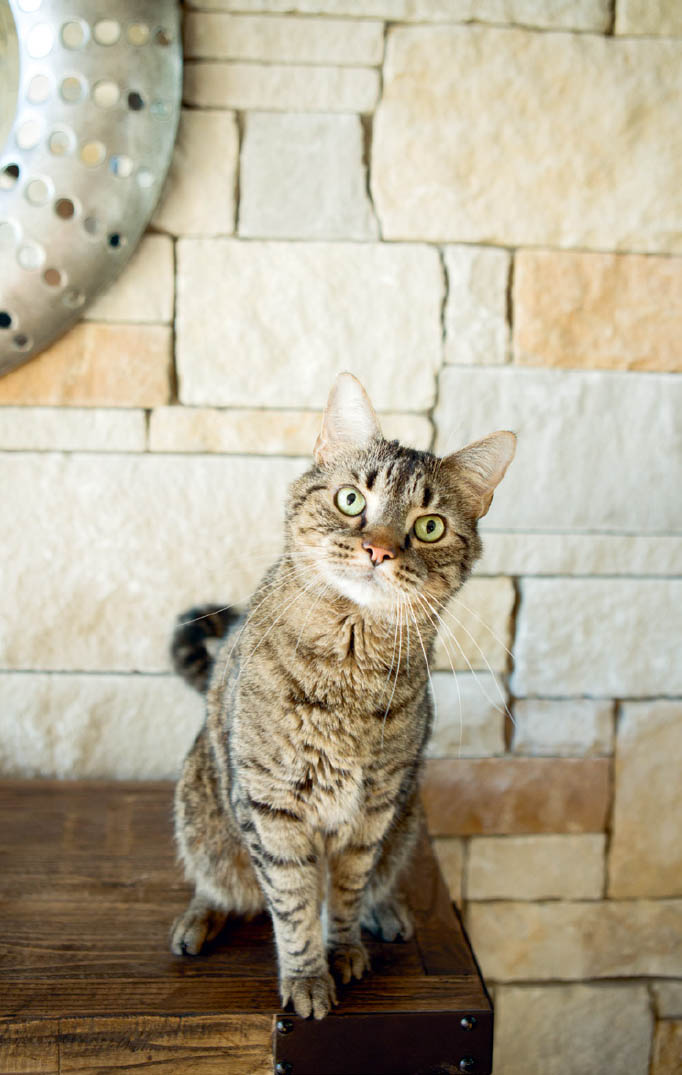
You can also take time to set up specific lighting with a little studio setup in your own home. You can give the cats plenty of time to get used to the equipment and any backgrounds, which is really helpful. Having the freedom to leave these items set up for a while may offer you creative opportunities that would not be possible if you were photographing in someone else’s home.
Photographing cats in your own home gives you the chance to experiment, make tons of mistakes, and gather ideas for other shoots that you might try with cats outside of your home environment. Maybe there are fun angles and perspectives or a new lighting technique you can try out and really take your time to see what works well. The more time you spend observing and photographing your own cats, the more opportunity you have to practice. Take advantage of it!
PHOTOGRAPHING SOMEONE ELSE’S CATS
Photographing other people’s cats is not the easiest activity, partially because cats tend to get a little more nervous around strangers than dogs do. I’ve even experienced this with my own cats when I have had photographers come into the house. This reality may be a challenge, but photographing other people’s cats is certainly not impossible.
I will always give my best effort to capture beautiful photographs for my clients. I find out as much as I can about the behaviors and character of the cat before I meet him or her. However, if a client calls me and tells me that their cat is very skittish, I cannot promise that I will be able to capture many portraits. That’s just the reality.
Give yourself plenty of time when photographing cats. I find that photographing them in their own environment is the best way to capture and interact with them. Bringing them into a studio can be quite stressful for them, and as a result, much more challenging for you.
When you enter a cat’s home (let’s call our subject “Moo”), be sure to spend time introducing yourself and allowing Moo to settle in with you and your equipment. Moo may want to smell your camera, bags, and you in order to get comfortable. Make your movements slow and subtle, and keep your energy subdued so that Moo doesn’t get too startled. If it’s OK with Moo’s owner, this may be a good time to offer a treat or two (if she’ll take it) to establish your new friendship. Pay close attention to how Moo responds to you, and be as patient as possible.
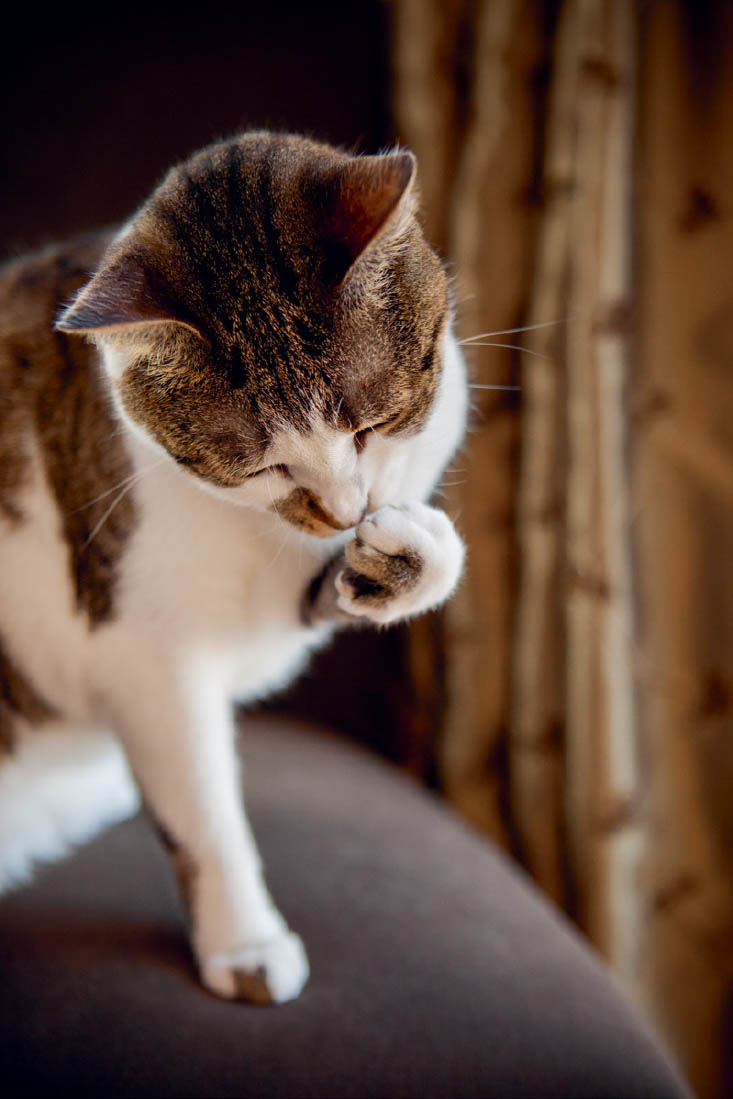
Communicate with Moo’s parents, and let them know that you came prepared to take your time. Letting them know that you’re expecting to take some time will often help them stay positive and calm. If Moo’s owners are assisting you, maintain clear communication with them throughout the shoot. Kindly indicate that you will be trying to get the cat’s attention unless you say otherwise. You don’t want them trying to force anything too quickly or adding to chaos, as you might lose Moo’s willingness to participate.
Posing Cats
OK, “posing cats” is a bit of an oxymoron. Cats don’t typically know how to sit, stand, or lie down like dogs (or maybe they all do and they’re just messing with us). Having acknowledged this, it is still possible to have a game plan that can produce results when it comes to photographing these glorious beings. To do this, we need to recognize their qualities as cats and as individual characters. We must think like cats.
While I love closeup images of cats and quite often create these types of images, it’s going to be important for you to move beyond the headshot and photograph cats in other positions, as well as have the creative option to include elements of their environment.
WHERE TO START
Much more so than with dogs, the location for photographing cats is often heavily weighted on where they like to spend time and are comfortable. While their favorite spots might change from day to day, these spots are at least good places to begin. Some of the typical locations cats tend to be comfortable might include:
- Couch
- Chair
- Cat hammock
- Cat tree
- Bed
- Table or chair
- A bag, box, or bowl
Cats that are permitted to go outdoors will have additional options for locations, including:
- Flowerpots
- Outdoor furniture
- Patios
- Trees
- Flowerbeds
By all means, don’t limit yourself to these locations, but keep them in mind. Cats generally seem to feel comfortable off the ground, but you may encounter a cat that is perfectly content to sprawl out on the carpet or wood floor.
If you have allocated the time for it, you can choose to wait until the cat gets used to you and just settles in comfortably somewhere before you start photographing. This may take a little more time and gives you less control over your backgrounds but is a totally viable option.
If you discover a spot within a location that might lend itself to a stunning composition, you can make an effort to lure the cat to that location with a treat or toy or simply physically bring them there and see if you can get them to stay with a treat or good ol’ fashioned love fest. As a note of caution, I don’t generally recommend picking up other people’s cats or any other pet without checking in with the pet parent beforehand.

PHYSICAL HANDLING
I often physically handle the animals I photograph, as long as I’ve checked in with the pet parent and I’m paying attention to the important communication signals. Physically connecting with the animals I photograph can be very helpful and often necessary for animals that aren’t very trained. I might adjust their position slightly, have them to sit or lie down by applying a gentle amount of guidance, or pick them up to place them where I want them for a composition or specific body position. In the case of cats that are pretty calm, I will pet them with one hand as I photograph them with the other. In between petting, they may change their body positioning or expression, and sometimes they will roll over onto their back, exposing their belly. I will continue to intermittingly pet them and remove my hand as I press the shutter.
Sometimes I find that if I keep petting a cat or even just keep my hand on them after I have positioned them, they kind of give in to being in that new spot or body position.
LIMITED ACCESS
Once you decide where you want to photograph, I highly recommend closing all doors that aren’t part of the portrait and limiting the access to rooms and spaces that you aren’t using in the creation of the photographs. You don’t want to find yourself chasing a cat around a house unnecessarily, not only because it takes a lot of extra energy and effort on your part, but mostly because cats can get extra nervous or excited with this kind of activity going on around them.
BACKGROUNDS
One of the logistical advantages of photographing smaller animals like cats is that you can often photograph in smaller areas and can incorporate smaller background elements. For example, you can add a splash of color as a background element with a section of a couch or chair or small area of a wall. I’ve even used the side of a refrigerator as a white background that worked quite nicely.
THE DETAILS
I love the details of cats—whiskers, paws, special markings, tails, or beautiful eyes. It helps to work with a lens that allows you to photograph close up in some way rather than having to overly crop an image later. I tend to prefer images that are captured in-camera as tight frames rather than extreme crops.
USING YOUR RESEARCH
Use the information you’ve gathered about the cat to help you generate ideas about where and how you want to photograph them. As we know, most cats enjoy sleeping, but beyond that, what are the activities they enjoy? Some possibilities may include:
- Being brushed by their pet parent
- Drinking water from the faucet
- Chasing a laser light
- Playing or hiding under the bed covers
- Getting their belly rubbed
GETTING THEIR ATTENTION
Like with dogs, getting a cat’s attention may vary drastically from animal to animal. This is why you’ll want to come prepared with your bag of tricks (both mental and physical). Cats are generally more responsive to visual stimulation than dogs are, so you’ll want to start using toys and tricks that might capture their eye first. Here are some items you can use to attempt to gain a cat’s attention:
- Toys they already have and enjoy
- New toys that might spark their curiosity (for variety)
- Catnip—placed in an area where you’d love to photograph the cat if they are being lethargic
- Thin, curly sticks (from the floral section in craft stores). They’re lightweight enough for you to use as a way to direct their gaze
- Feathers and cat teasers
- Pipe cleaners, curled up or straight
- Ribbons and string—with a knot tied at the end to provide a little weight and give the cat more to try to grab
- Sounds—created with your mouth or even through noise-making toys. You’ll know right away if they are effective
- Tapping on the window or scratching the wall or fabric of a piece of furniture
Fuego was having fun climbing this tree, and I used a piece of long grass to get his attention for this image.
Just having these objects won’t ensure that you get a cat’s attention. I will often see new pet photographers holding a toy next to their lens without moving it, expecting the cat to become interested. While this photographer might get lucky and the cat will gaze up into the lens, a stationary toy isn’t going to do much for you or them.
IF YOU’RE USING TOYS OR ATTENTION-GETTERS, everything you do to get the cat’s attention needs to either evoke some sense of response based on their sense of curiosity or become part of play. Use these tools sporadically and alternate your movements. I find that quick movements with toys tend to evoke more of response than slow ones.
Scratching sounds tend to be quite effective, for example, scratching your lens hood or a reflector or nearby surface. Crinkling aluminum foil or plastic bags is another way to generate some interest. If whatever you’re doing doesn’t elicit the desired response, stop and move on to something else quickly. Like dogs, cats can get desensitized and you’ll want to retain as much of their energy as possible. Treats and stinky food can also work well for cats who don’t seem to respond to anything else. I once photographed a blind and deaf cat and was able to use the scent of food to position them for a portrait. While treats aren’t typically my “go-to,” I have had very good results with them.
If the cat you are photographing shows signs of fear or aggression as you introduce any of your attention-getting toys or tactics, take a break for a few minutes. Perhaps move to a different room within the location, or try using a longer lens if he or she continues to act nervous or overly stressed.
If the cat you are photographing completely disappears, try to have the pet parent find them, rather than chase them around the house. If, after you try treats, play, and other luring techniques, you are unable to get the cat where you want him or her, you may need to settle for photographs by the bed, under a couch, or hiding by a curtain.
WORKING WITH KITTENS
I love photographing kittens. Kitten behavior is very different from adult cats, and most of the considerations regarding the demeanor of adult cats flies out the window when photographing kittens. While there are always exceptions, kittens tend to be quite playful and curious and are not generally as nervous about changes to their environment as adult cats. The challenge when photographing these little guys and gals is typically that their energy is quite high, and they don’t like to stay in one place for long.
Attention-getting rules and techniques all apply to kittens, with the exception of catnip, which for some reason, they don’t respond to until they get older. The best option for photographing kittens is to lure them wherever you’d like them to go with some kind of toy, laser light, or cat teaser; or physically pick them up and move them.
Kittens tend to pounce a lot so be ready for that. Once I was photographing a kitten that jumped on top of my lens!
I loved photographing this kitten with the chandelier and the simple, soft-toned background. Kittens are typically so curious and playful. For this image, I set up studio lights and lured the kitten to the table with a cat teaser.
The best light for photographing cats depends on the mood I’m trying to convey, the demeanor of the cat I’m photographing, and the general time I have to accomplish what I need to in a given session. If I have a very specific idea in mind that requires the look of studio lights or I really need the extra light for exposure and depth of field, I may choose to set up lights and see if the cat will be accommodating. If I have an assistant, I may be able to accomplish more by having them set up the lights for me while I photograph in another room.
Most of the time, however, I prefer harnessing the natural beauty of window light when photographing cats indoors and find that working with natural light helps me focus on capturing expressions and interactions and gives me more time to photograph.
I highly recommend trying all options so you can experience the values of each approach. You may determine, like me, that a combination of lighting approaches is most helpful. You get to choose what works best for you!
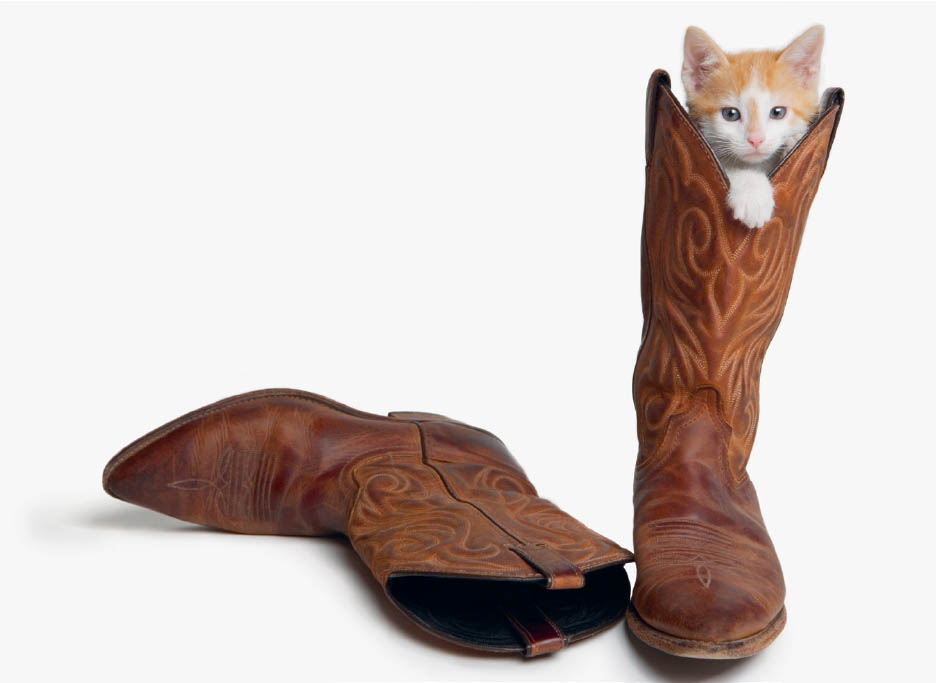
Window light is such a great resource for cat portraits. You don’t always have to show the window, but in this image, I chose to reference the curtains as a compositional element.
WINDOW LIGHT
Window light is my favorite kind of light for photographing cats. It helps that cats tend to be drawn to the warmth of sunlight spilling through a window. While this is, of course, not the only light option for cat photography, it’s certainly one that you’ll want to be open to as you work on location.
I typically set my ISO to 400 as a starting point for window light situations and try to get the room as bright as possible by opening as many curtains and shutters as I can. Any extra light in the room will help fill in some of the contrast if it’s too extreme.
If the contrast is way too high, I’ll tape diffusion material to the window to soften the light a bit. If there are strong beams of light coming directly through the window causing bright highlights and dark shadows, exposure can be difficult and the diffusion material is an inexpensive and quick solution.
Since the window light often creates a backlit situation, I like using a foam core reflector or other type of white or silver reflector to bounce light back onto the cat. If I do this, I need to watch my reflection in the glass so that my reflection isn’t a huge distraction in the images. If this happens, I’ll adjust my perspective. If I don’t have an extra hand to hold a reflector, I will prop it up against a chair, a wall, or anywhere else where I notice it making a difference. Cats don’t typically seem to get bothered by stationary reflectors, once they’re in place. If they fall over or move a lot, however, it can be startling to them.
When I am photographing a cat in a window-lit area, I will change my perspective as much as I can to see how many different images I can create while the cat is in one place, comfortably sleeping or just hanging out.
You can also use the contrast of window light to create more dramatically lit portraits. If you angle yourself in such a way that incorporates a darker background (either dark in color or not lit by the window light), the resulting images can look almost like studio-lit images and feel more dramatic. If you have a helper or the pet parent is willing and you want the cat to look outside, you can have your helper go outside and make movements with a toy to keep the cat’s gaze toward the window light.
STUDIO LIGHTS
I have used studio lights to photograph cats and know it can be a really beautiful option. It is not my go-to approach, mostly because this added element can cause undue stress and may mean that I don’t get the shot at all. Small strobes can sometimes act as a good in-between solution, because they’re a little less bulky.
If you are going to use studio light, either with a seamless background or environmental scene, you’ll likely need to lure the cat or cats to where you want them. Unless the cats you’re photographing are trained or super comfortable with strangers and strange situations, you may need the help of an extra hand, as well as a dash of extra patience.
If you’re having trouble getting the cat to be comfortable, my suggestion is to choose a location where the cat already spends some time, so at least one element is familiar to them. I realize this isn’t always possible and that sometimes the best place for the cat isn’t the best place for the photograph. The most beautifully lit scene won’t do you a lot of good if the cat isn’t comfortable in it.
Don’t let the challenge of photographing cats stop you from following your vision of using studio lights in your favorite spot or with your favorite modifiers on location. I encourage you to think big and make all efforts to turn your vision into reality. Just be ready to adjust and be flexible, if needed!
If you find yourself photographing a cat that is comfortable with whatever situation he or she is in, try to get as creative as possible by moving yourself before moving the animal. This approach will help give you a lot more options in a given time frame.
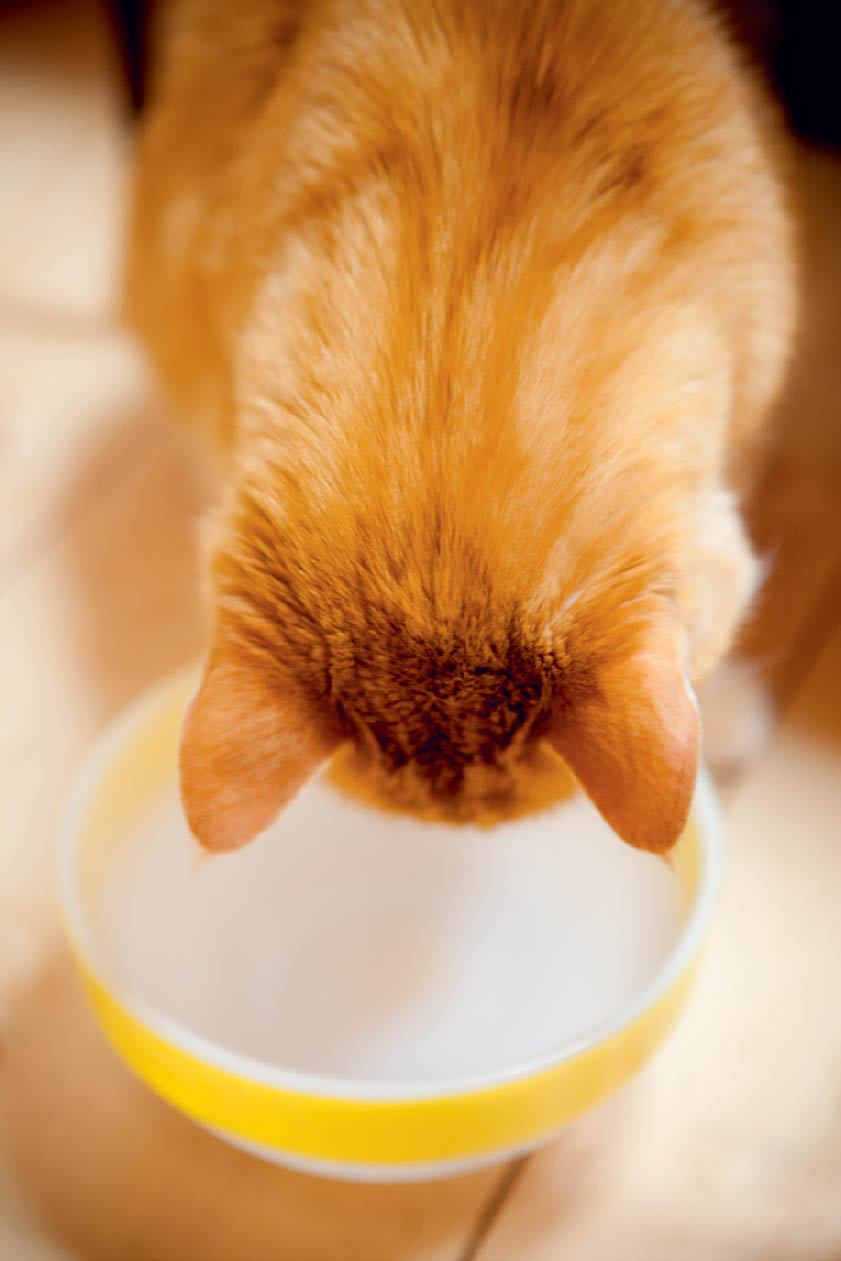
I changed my perspective and used a shallow depth of field (f/2.8) to create this image.
DEPTH OF FIELD
If a cat is napping or comfortable lying on a sofa by the window or you are limited within the location to make a big change, you can play around with depth of field to get some variety in your images. I know I can sometimes get a particular idea stuck in my head of what an image should look like based on the scene or location, and it’s important for me to remember that I can create lots of variety by changing the depth of field.
KEEP YOUR EYES OPEN
If the area in which you are photographing could use a little aesthetic help, see if you can move a piece of furniture or adjust your perspective to simplify it and make it more pleasing. Look for small areas with interesting color, texture, or shape to use as backgrounds. See if there are elements you can shoot through, like windows or doors, or perhaps incorporate framing devices like curtains or material to add something a little different to your images.
I tucked myself in between these curtains when I noticed the opportunity to use them as an interesting framing device. I waved the material around to get the kitten’s attention.
Photographing Cats with People
Cats offer unique companionship to their pet parents, and I love capturing their relationship with my camera. When it comes to photographing cats with people, the best thing we can do is bring a willingness to be flexible and patient and make it easy for everyone to be as relaxed as possible.
It would be so easy if all cats loved to be held when you want to hold them, wherever you want to hold them . . . and in front of strangers. The fact is, this isn’t always the case.
BEFORE YOU START
I always try to remember to have a short chat about the game plan before I start photographing people and cats together. I remind the pet parent that I will guide them and that if I want something different, I will let them know. I ask that if they are looking at their cat, they try to refrain from a lot of talking and keep their interactions to a physical connection. If they want to pet their cat, I will want to avoid the “claw” hand, so I ask that their hands stay open and soft. This little pep talk seems helpful, because it guides them from the beginning toward what I want visually and gives them a few directions.
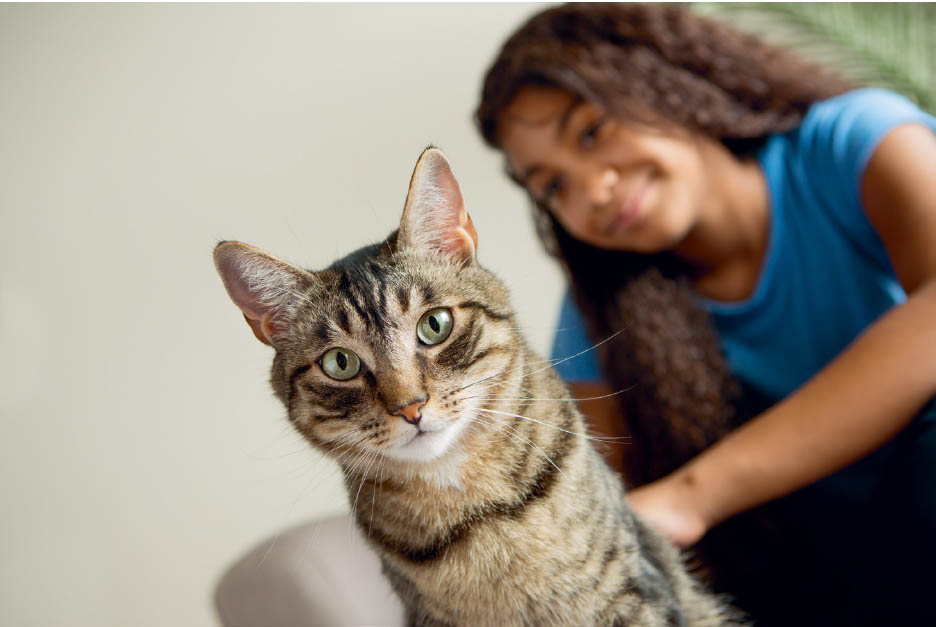
DIRECTED INTERACTIONS
If you run into a situation where the cat and pet parent you are photographing happen to be very easygoing and comfortable, you may find success in giving the pet parent a lot of direction regarding posing and body positioning.
Some cats love to be snuggled and held, and if that’s the case you are definitely going to want to take advantage! You can photograph the person on the same level as the cat or have the cat in his or her lap, maybe even positioned cheek to cheek. In these situations, you can provide specific directions for where you want their hands positioned, for example, and really fine-tune the image as much as possible. You don’t always have to have the person or cat looking into the lens and might direct the person to look at the cat or elsewhere.
You might work this way for a little while and then switch gears to a more passive role as photographer if you notice the cat needs a break or the energy has stagnated.
BEING AN OBSERVER
If I find the owner or cat to be a little nervous or I simply feel like trying a different approach, I may choose to start the session by taking on a more passive or reactive role. I may ask the person and the cat to interact within an environment that works for me visually and is comfortable for the animal and give minimal instruction. With this approach, I am reacting to what happens rather than actively directing my subjects. While the observer or reactive approach has similarities to my directed, proactive portrait approach, it’s different in the sense that it can be more activity-based. Creating at least a portion of the portraits this way can take a little pressure off everyone feeling that they have to look a certain way or even look at the camera!
By being an observer, I am waiting for a moment that captures that connection between the two subjects, where the person is fully in the moment, enjoying their time with their cat.
If the cat likes to be brushed, it might create a great opportunity for a portrait or sweet moment to be documented. A pet owner gently petting and nuzzling his or her cat can help to convey an authentic moment of connection between the two. If a cat is feeling playful, photographing play between a cat and owner can also be a fun documentation of their bond.
Photographing this bond between people and animals is one of my favorite things to do. I like to encourage interaction on a physical level and remind them to smile as it comes naturally but not to talk too much, because it’s hard to photograph a talking person without it looking awkward. I need to make these moments translate well into photographs, and these are all ways that help me do that.
In order to make sure I don’t miss too many sweet moments, I will have the pet parent wait to interact and play until I am initially set up with my exposure and lighting. If a major change occurs that requires me to regroup with my settings or equipment as interaction is happening, I might ask for a pause in activity in order to save everyone’s energy.
You don’t necessarily have to commit to photographing a session that is fully directed or fully created with more of an observer role. It’s a good idea to have an awareness, however, of your position as you move along during the session so you can clearly communicate with your subjects. Most of the time when I am photographing I find myself transitioning from a more passive approach to a proactive one. If I see a body position or interaction that I really love, I might pause a passive approach and direct for a few minutes. I communicate with the person I am photographing along the way as much as I can.
During cat portrait sessions, the cats are the ones that usually dictate the role you will need to take! And no matter which approach you choose, it’s important to continue to provide positive feedback and encouragement to whomever is in front of your lens.
PEOPLE AS PROPS WITH CATS
Because cats don’t typically follow directions as well as dogs (although I am convinced they know exactly what we are saying and choose to ignore us half the time), it can be helpful to use their human as a “prop” for the portraits. For this approach, the human will be there to hold the cat gently in place with a hand or in their lap. I can choose to crop out the human’s head and focus in closely on the animal and include the pet parents’ hands as a nice reference. I also might choose to use a shallow depth of field, focus on the cat, and let the pet parent fall out of focus. This is a good option when Mr. Kitty isn’t cooperating or just as another creative possibility to try.
PRACTICE MAKES PURRFECT
Go for it! You now have a ton of knowledge to get you started with your next cat portrait session. If you have your own cats, start practicing with them or with a friend’s cat. Pay special attention to their reaction to you, maintain an awareness of your energy, and start to build your toolbox of techniques for getting creative on location with these loving companions.
